Business Law Report: Employment, Equality, and European Union Law
VerifiedAdded on 2020/01/06
|11
|3510
|138
Report
AI Summary
This business law report provides a comprehensive overview of key legal aspects relevant to businesses operating in the UK. It begins with an analysis of the Employment Rights Act 1996, detailing the sources and components of employment contracts, as well as the common law duties of both employees and employers. The report then delves into the Equality Act 2010, examining its scope, structure, and the various types of discrimination it addresses, alongside the actions employers should take to ensure compliance. Finally, the report explores the influence of European Union Law on UK business law, outlining the main sources of EU law and its impact on UK lawfulness. The report covers topics such as employment contracts, discrimination, and the legal obligations of employers and employees, providing a thorough understanding of the legal landscape. This report is designed to help students understand the legal requirements for business operations within the UK and is available on Desklib, a platform dedicated to providing students with the resources they need to succeed.
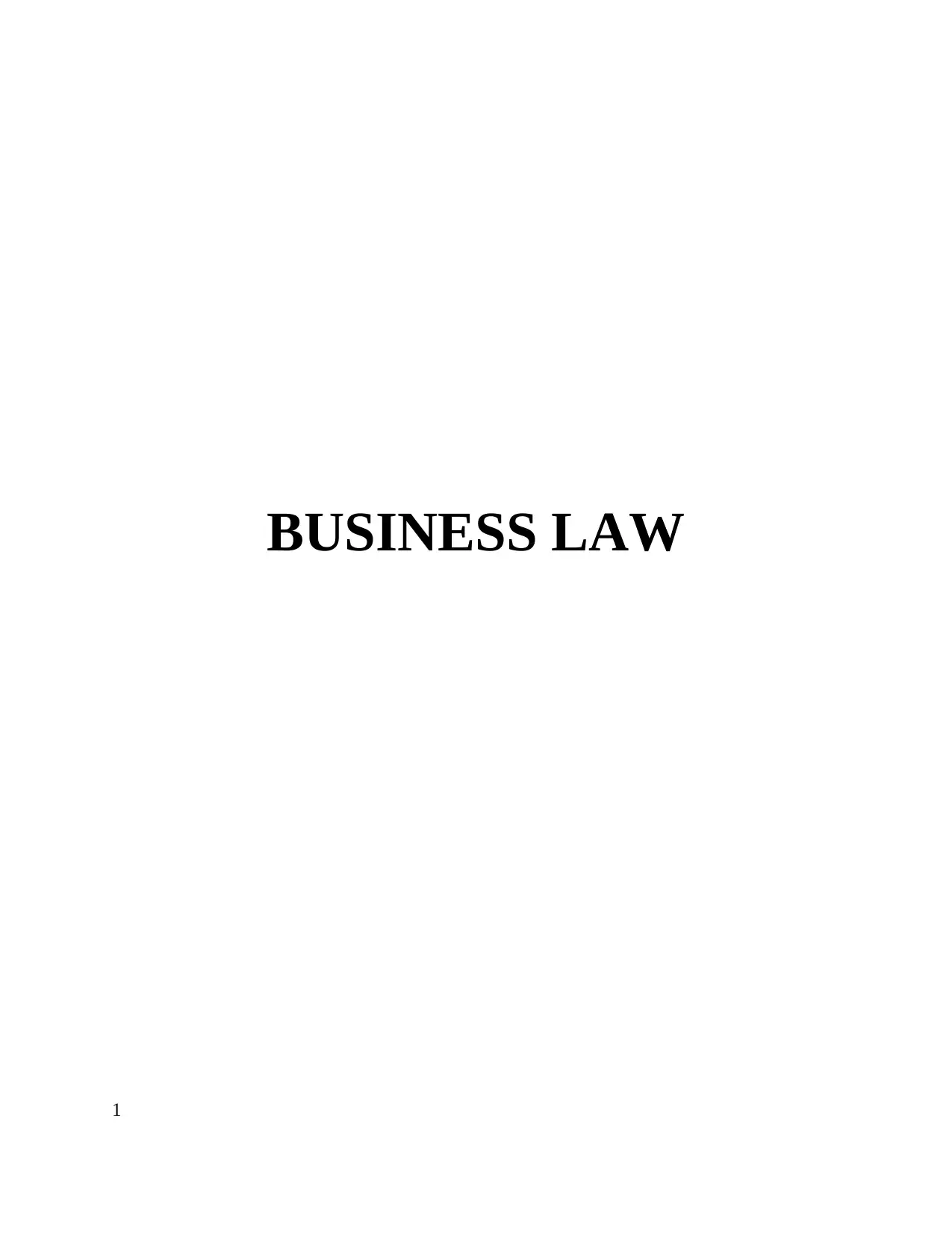
BUSINESS LAW
1
1
Paraphrase This Document
Need a fresh take? Get an instant paraphrase of this document with our AI Paraphraser
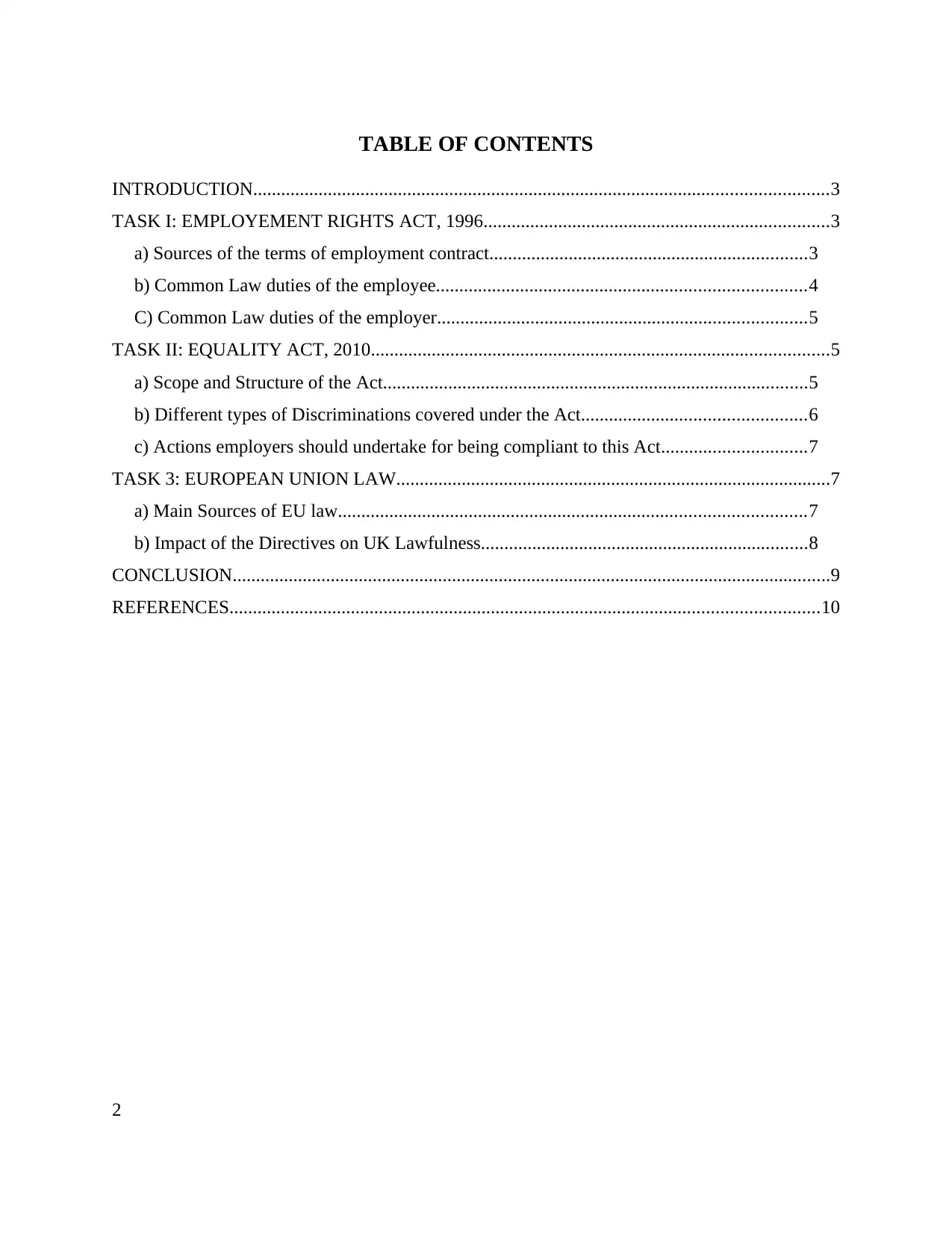
TABLE OF CONTENTS
INTRODUCTION...........................................................................................................................3
TASK I: EMPLOYEMENT RIGHTS ACT, 1996..........................................................................3
a) Sources of the terms of employment contract....................................................................3
b) Common Law duties of the employee...............................................................................4
C) Common Law duties of the employer...............................................................................5
TASK II: EQUALITY ACT, 2010..................................................................................................5
a) Scope and Structure of the Act...........................................................................................5
b) Different types of Discriminations covered under the Act................................................6
c) Actions employers should undertake for being compliant to this Act...............................7
TASK 3: EUROPEAN UNION LAW.............................................................................................7
a) Main Sources of EU law....................................................................................................7
b) Impact of the Directives on UK Lawfulness......................................................................8
CONCLUSION................................................................................................................................9
REFERENCES..............................................................................................................................10
2
INTRODUCTION...........................................................................................................................3
TASK I: EMPLOYEMENT RIGHTS ACT, 1996..........................................................................3
a) Sources of the terms of employment contract....................................................................3
b) Common Law duties of the employee...............................................................................4
C) Common Law duties of the employer...............................................................................5
TASK II: EQUALITY ACT, 2010..................................................................................................5
a) Scope and Structure of the Act...........................................................................................5
b) Different types of Discriminations covered under the Act................................................6
c) Actions employers should undertake for being compliant to this Act...............................7
TASK 3: EUROPEAN UNION LAW.............................................................................................7
a) Main Sources of EU law....................................................................................................7
b) Impact of the Directives on UK Lawfulness......................................................................8
CONCLUSION................................................................................................................................9
REFERENCES..............................................................................................................................10
2
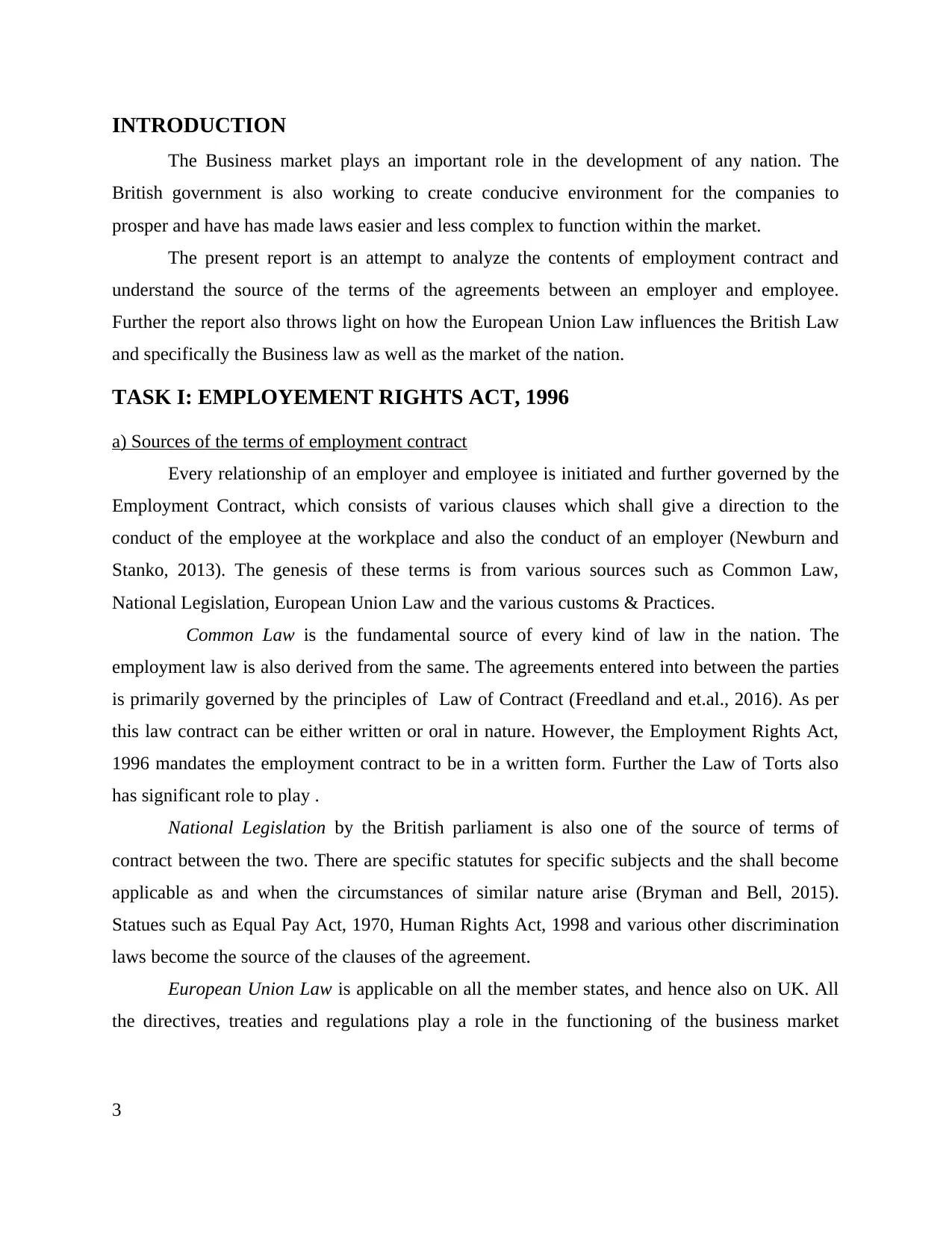
INTRODUCTION
The Business market plays an important role in the development of any nation. The
British government is also working to create conducive environment for the companies to
prosper and have has made laws easier and less complex to function within the market.
The present report is an attempt to analyze the contents of employment contract and
understand the source of the terms of the agreements between an employer and employee.
Further the report also throws light on how the European Union Law influences the British Law
and specifically the Business law as well as the market of the nation.
TASK I: EMPLOYEMENT RIGHTS ACT, 1996
a) Sources of the terms of employment contract
Every relationship of an employer and employee is initiated and further governed by the
Employment Contract, which consists of various clauses which shall give a direction to the
conduct of the employee at the workplace and also the conduct of an employer (Newburn and
Stanko, 2013). The genesis of these terms is from various sources such as Common Law,
National Legislation, European Union Law and the various customs & Practices.
Common Law is the fundamental source of every kind of law in the nation. The
employment law is also derived from the same. The agreements entered into between the parties
is primarily governed by the principles of Law of Contract (Freedland and et.al., 2016). As per
this law contract can be either written or oral in nature. However, the Employment Rights Act,
1996 mandates the employment contract to be in a written form. Further the Law of Torts also
has significant role to play .
National Legislation by the British parliament is also one of the source of terms of
contract between the two. There are specific statutes for specific subjects and the shall become
applicable as and when the circumstances of similar nature arise (Bryman and Bell, 2015).
Statues such as Equal Pay Act, 1970, Human Rights Act, 1998 and various other discrimination
laws become the source of the clauses of the agreement.
European Union Law is applicable on all the member states, and hence also on UK. All
the directives, treaties and regulations play a role in the functioning of the business market
3
The Business market plays an important role in the development of any nation. The
British government is also working to create conducive environment for the companies to
prosper and have has made laws easier and less complex to function within the market.
The present report is an attempt to analyze the contents of employment contract and
understand the source of the terms of the agreements between an employer and employee.
Further the report also throws light on how the European Union Law influences the British Law
and specifically the Business law as well as the market of the nation.
TASK I: EMPLOYEMENT RIGHTS ACT, 1996
a) Sources of the terms of employment contract
Every relationship of an employer and employee is initiated and further governed by the
Employment Contract, which consists of various clauses which shall give a direction to the
conduct of the employee at the workplace and also the conduct of an employer (Newburn and
Stanko, 2013). The genesis of these terms is from various sources such as Common Law,
National Legislation, European Union Law and the various customs & Practices.
Common Law is the fundamental source of every kind of law in the nation. The
employment law is also derived from the same. The agreements entered into between the parties
is primarily governed by the principles of Law of Contract (Freedland and et.al., 2016). As per
this law contract can be either written or oral in nature. However, the Employment Rights Act,
1996 mandates the employment contract to be in a written form. Further the Law of Torts also
has significant role to play .
National Legislation by the British parliament is also one of the source of terms of
contract between the two. There are specific statutes for specific subjects and the shall become
applicable as and when the circumstances of similar nature arise (Bryman and Bell, 2015).
Statues such as Equal Pay Act, 1970, Human Rights Act, 1998 and various other discrimination
laws become the source of the clauses of the agreement.
European Union Law is applicable on all the member states, and hence also on UK. All
the directives, treaties and regulations play a role in the functioning of the business market
3
⊘ This is a preview!⊘
Do you want full access?
Subscribe today to unlock all pages.

Trusted by 1+ million students worldwide
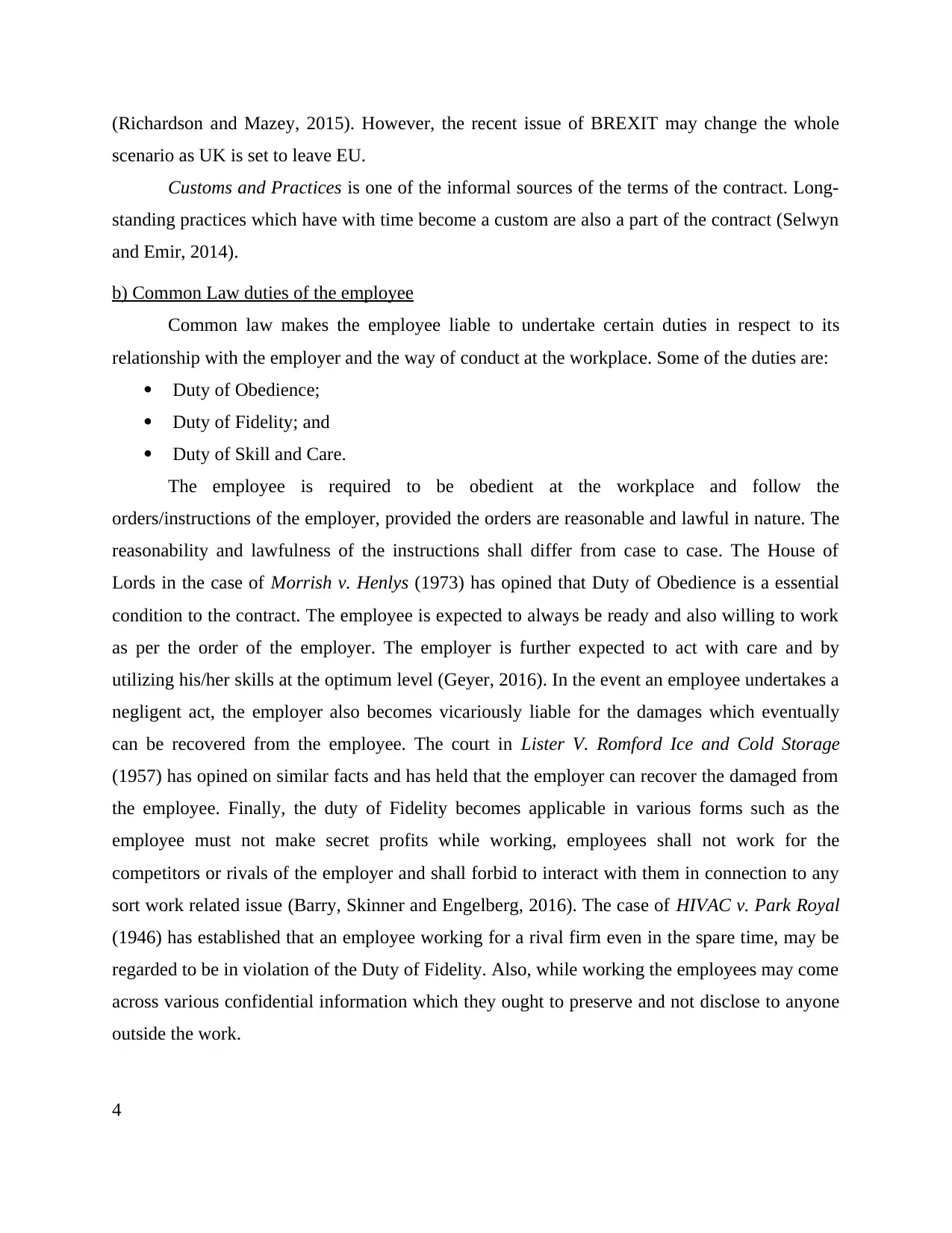
(Richardson and Mazey, 2015). However, the recent issue of BREXIT may change the whole
scenario as UK is set to leave EU.
Customs and Practices is one of the informal sources of the terms of the contract. Long-
standing practices which have with time become a custom are also a part of the contract (Selwyn
and Emir, 2014).
b) Common Law duties of the employee
Common law makes the employee liable to undertake certain duties in respect to its
relationship with the employer and the way of conduct at the workplace. Some of the duties are:
Duty of Obedience;
Duty of Fidelity; and
Duty of Skill and Care.
The employee is required to be obedient at the workplace and follow the
orders/instructions of the employer, provided the orders are reasonable and lawful in nature. The
reasonability and lawfulness of the instructions shall differ from case to case. The House of
Lords in the case of Morrish v. Henlys (1973) has opined that Duty of Obedience is a essential
condition to the contract. The employee is expected to always be ready and also willing to work
as per the order of the employer. The employer is further expected to act with care and by
utilizing his/her skills at the optimum level (Geyer, 2016). In the event an employee undertakes a
negligent act, the employer also becomes vicariously liable for the damages which eventually
can be recovered from the employee. The court in Lister V. Romford Ice and Cold Storage
(1957) has opined on similar facts and has held that the employer can recover the damaged from
the employee. Finally, the duty of Fidelity becomes applicable in various forms such as the
employee must not make secret profits while working, employees shall not work for the
competitors or rivals of the employer and shall forbid to interact with them in connection to any
sort work related issue (Barry, Skinner and Engelberg, 2016). The case of HIVAC v. Park Royal
(1946) has established that an employee working for a rival firm even in the spare time, may be
regarded to be in violation of the Duty of Fidelity. Also, while working the employees may come
across various confidential information which they ought to preserve and not disclose to anyone
outside the work.
4
scenario as UK is set to leave EU.
Customs and Practices is one of the informal sources of the terms of the contract. Long-
standing practices which have with time become a custom are also a part of the contract (Selwyn
and Emir, 2014).
b) Common Law duties of the employee
Common law makes the employee liable to undertake certain duties in respect to its
relationship with the employer and the way of conduct at the workplace. Some of the duties are:
Duty of Obedience;
Duty of Fidelity; and
Duty of Skill and Care.
The employee is required to be obedient at the workplace and follow the
orders/instructions of the employer, provided the orders are reasonable and lawful in nature. The
reasonability and lawfulness of the instructions shall differ from case to case. The House of
Lords in the case of Morrish v. Henlys (1973) has opined that Duty of Obedience is a essential
condition to the contract. The employee is expected to always be ready and also willing to work
as per the order of the employer. The employer is further expected to act with care and by
utilizing his/her skills at the optimum level (Geyer, 2016). In the event an employee undertakes a
negligent act, the employer also becomes vicariously liable for the damages which eventually
can be recovered from the employee. The court in Lister V. Romford Ice and Cold Storage
(1957) has opined on similar facts and has held that the employer can recover the damaged from
the employee. Finally, the duty of Fidelity becomes applicable in various forms such as the
employee must not make secret profits while working, employees shall not work for the
competitors or rivals of the employer and shall forbid to interact with them in connection to any
sort work related issue (Barry, Skinner and Engelberg, 2016). The case of HIVAC v. Park Royal
(1946) has established that an employee working for a rival firm even in the spare time, may be
regarded to be in violation of the Duty of Fidelity. Also, while working the employees may come
across various confidential information which they ought to preserve and not disclose to anyone
outside the work.
4
Paraphrase This Document
Need a fresh take? Get an instant paraphrase of this document with our AI Paraphraser

C) Common Law duties of the employer
The employer is also required to act in a certain manner and the same is governed by the
principles of Common Law, which imposes the following duties:
Duty to provide work;
Duty to pay wages;
Duty to safety and care; and
Duty of mutual trust and confidence.
The basic duty of employer is to assign work to the employees or which they are being
paid. The case of Clayton & Waller v. Oliver (1930) has made a law by stating that in the event
the employee is a performer which is giving him/her publicity, the employer could not deny him
work. Duty to pay wages is a explicit and essential condition of the employment contract, and the
failure of the same shall result in repudiation of the contract. Bal P.M., Kooij D.T. and Rousseau
D.M. (2015) have stated that an employer after hiring the staff cannot unilaterally cut the pays.
The prime responsibility of the management of any company is to provide the workforce with a
safe and secure working environment. This duty is bifurcated into – duty to provide a secured
system of work, duty to recruit competent and skilled employees and lastly, the duty to provide a
safe and clean working place. It is the duty of the management to ensure that all the equipments
and machines are functioning in a proper manner and that the workplace is hygienic and clean
enough to work in a healthy manner. Every effort shall be made from their part to minimize the
level of risks and injuries. Finally, the duty of mutual trust and confidence requires the
management and director level people to act in a manner which is not detrimental to their
relationship with the workforce. The employers are required to act in a fair and non-arbitrary
manner for the betterment of the employees.
TASK II: EQUALITY ACT, 2010
a) Scope and Structure of the Act
The Equality Act, 2010 came into force in October, 2010 after receiving the Royal Assent
in April of the same year. The Act encompasses nine major previously existing statutes of anti-
discrimination laws. The legislation is consisted of 16 Parts with around 28 Schedules, clearly
demarcating its territorial jurisdiction within the nation. Northern Ireland has been specifically
5
The employer is also required to act in a certain manner and the same is governed by the
principles of Common Law, which imposes the following duties:
Duty to provide work;
Duty to pay wages;
Duty to safety and care; and
Duty of mutual trust and confidence.
The basic duty of employer is to assign work to the employees or which they are being
paid. The case of Clayton & Waller v. Oliver (1930) has made a law by stating that in the event
the employee is a performer which is giving him/her publicity, the employer could not deny him
work. Duty to pay wages is a explicit and essential condition of the employment contract, and the
failure of the same shall result in repudiation of the contract. Bal P.M., Kooij D.T. and Rousseau
D.M. (2015) have stated that an employer after hiring the staff cannot unilaterally cut the pays.
The prime responsibility of the management of any company is to provide the workforce with a
safe and secure working environment. This duty is bifurcated into – duty to provide a secured
system of work, duty to recruit competent and skilled employees and lastly, the duty to provide a
safe and clean working place. It is the duty of the management to ensure that all the equipments
and machines are functioning in a proper manner and that the workplace is hygienic and clean
enough to work in a healthy manner. Every effort shall be made from their part to minimize the
level of risks and injuries. Finally, the duty of mutual trust and confidence requires the
management and director level people to act in a manner which is not detrimental to their
relationship with the workforce. The employers are required to act in a fair and non-arbitrary
manner for the betterment of the employees.
TASK II: EQUALITY ACT, 2010
a) Scope and Structure of the Act
The Equality Act, 2010 came into force in October, 2010 after receiving the Royal Assent
in April of the same year. The Act encompasses nine major previously existing statutes of anti-
discrimination laws. The legislation is consisted of 16 Parts with around 28 Schedules, clearly
demarcating its territorial jurisdiction within the nation. Northern Ireland has been specifically
5
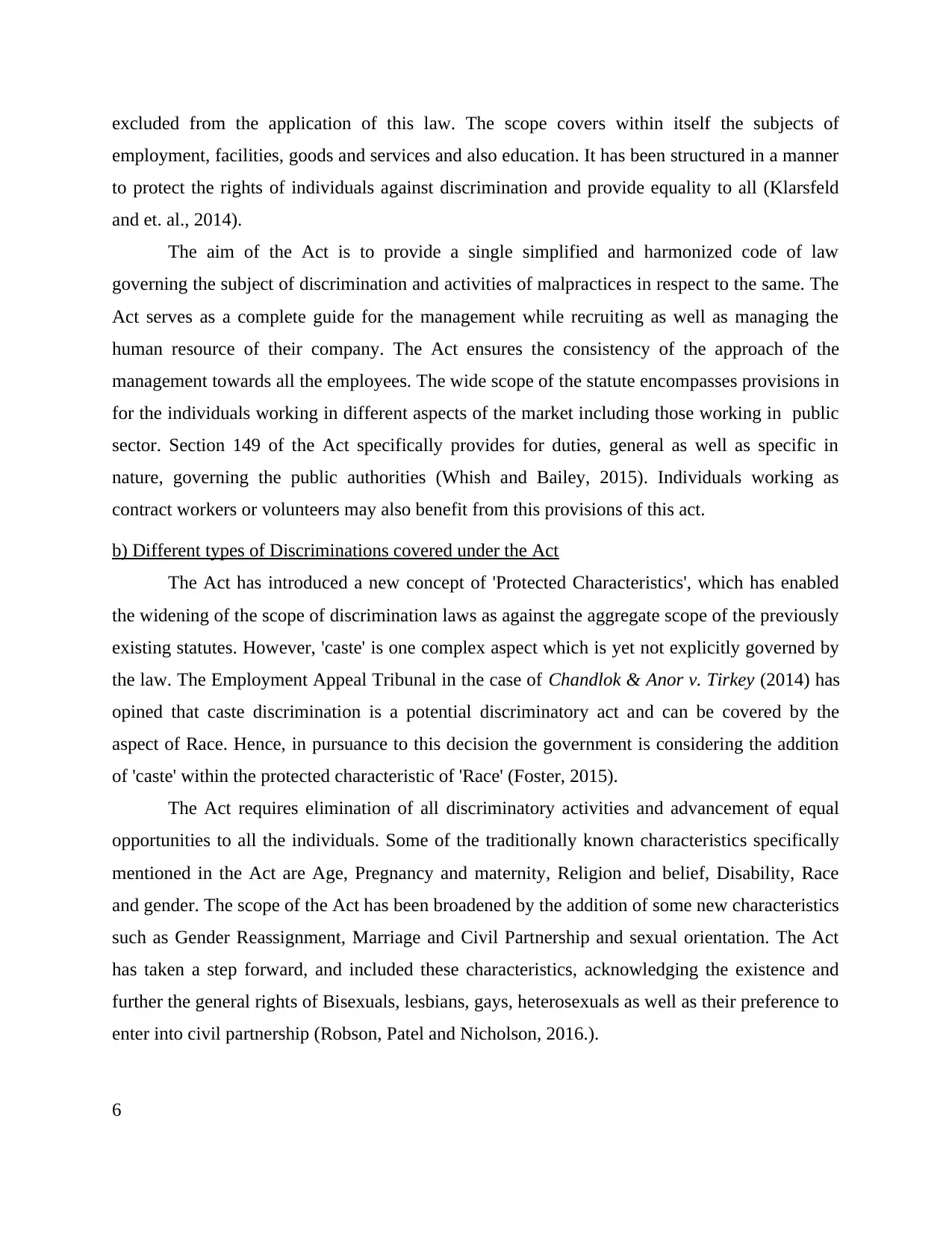
excluded from the application of this law. The scope covers within itself the subjects of
employment, facilities, goods and services and also education. It has been structured in a manner
to protect the rights of individuals against discrimination and provide equality to all (Klarsfeld
and et. al., 2014).
The aim of the Act is to provide a single simplified and harmonized code of law
governing the subject of discrimination and activities of malpractices in respect to the same. The
Act serves as a complete guide for the management while recruiting as well as managing the
human resource of their company. The Act ensures the consistency of the approach of the
management towards all the employees. The wide scope of the statute encompasses provisions in
for the individuals working in different aspects of the market including those working in public
sector. Section 149 of the Act specifically provides for duties, general as well as specific in
nature, governing the public authorities (Whish and Bailey, 2015). Individuals working as
contract workers or volunteers may also benefit from this provisions of this act.
b) Different types of Discriminations covered under the Act
The Act has introduced a new concept of 'Protected Characteristics', which has enabled
the widening of the scope of discrimination laws as against the aggregate scope of the previously
existing statutes. However, 'caste' is one complex aspect which is yet not explicitly governed by
the law. The Employment Appeal Tribunal in the case of Chandlok & Anor v. Tirkey (2014) has
opined that caste discrimination is a potential discriminatory act and can be covered by the
aspect of Race. Hence, in pursuance to this decision the government is considering the addition
of 'caste' within the protected characteristic of 'Race' (Foster, 2015).
The Act requires elimination of all discriminatory activities and advancement of equal
opportunities to all the individuals. Some of the traditionally known characteristics specifically
mentioned in the Act are Age, Pregnancy and maternity, Religion and belief, Disability, Race
and gender. The scope of the Act has been broadened by the addition of some new characteristics
such as Gender Reassignment, Marriage and Civil Partnership and sexual orientation. The Act
has taken a step forward, and included these characteristics, acknowledging the existence and
further the general rights of Bisexuals, lesbians, gays, heterosexuals as well as their preference to
enter into civil partnership (Robson, Patel and Nicholson, 2016.).
6
employment, facilities, goods and services and also education. It has been structured in a manner
to protect the rights of individuals against discrimination and provide equality to all (Klarsfeld
and et. al., 2014).
The aim of the Act is to provide a single simplified and harmonized code of law
governing the subject of discrimination and activities of malpractices in respect to the same. The
Act serves as a complete guide for the management while recruiting as well as managing the
human resource of their company. The Act ensures the consistency of the approach of the
management towards all the employees. The wide scope of the statute encompasses provisions in
for the individuals working in different aspects of the market including those working in public
sector. Section 149 of the Act specifically provides for duties, general as well as specific in
nature, governing the public authorities (Whish and Bailey, 2015). Individuals working as
contract workers or volunteers may also benefit from this provisions of this act.
b) Different types of Discriminations covered under the Act
The Act has introduced a new concept of 'Protected Characteristics', which has enabled
the widening of the scope of discrimination laws as against the aggregate scope of the previously
existing statutes. However, 'caste' is one complex aspect which is yet not explicitly governed by
the law. The Employment Appeal Tribunal in the case of Chandlok & Anor v. Tirkey (2014) has
opined that caste discrimination is a potential discriminatory act and can be covered by the
aspect of Race. Hence, in pursuance to this decision the government is considering the addition
of 'caste' within the protected characteristic of 'Race' (Foster, 2015).
The Act requires elimination of all discriminatory activities and advancement of equal
opportunities to all the individuals. Some of the traditionally known characteristics specifically
mentioned in the Act are Age, Pregnancy and maternity, Religion and belief, Disability, Race
and gender. The scope of the Act has been broadened by the addition of some new characteristics
such as Gender Reassignment, Marriage and Civil Partnership and sexual orientation. The Act
has taken a step forward, and included these characteristics, acknowledging the existence and
further the general rights of Bisexuals, lesbians, gays, heterosexuals as well as their preference to
enter into civil partnership (Robson, Patel and Nicholson, 2016.).
6
⊘ This is a preview!⊘
Do you want full access?
Subscribe today to unlock all pages.

Trusted by 1+ million students worldwide
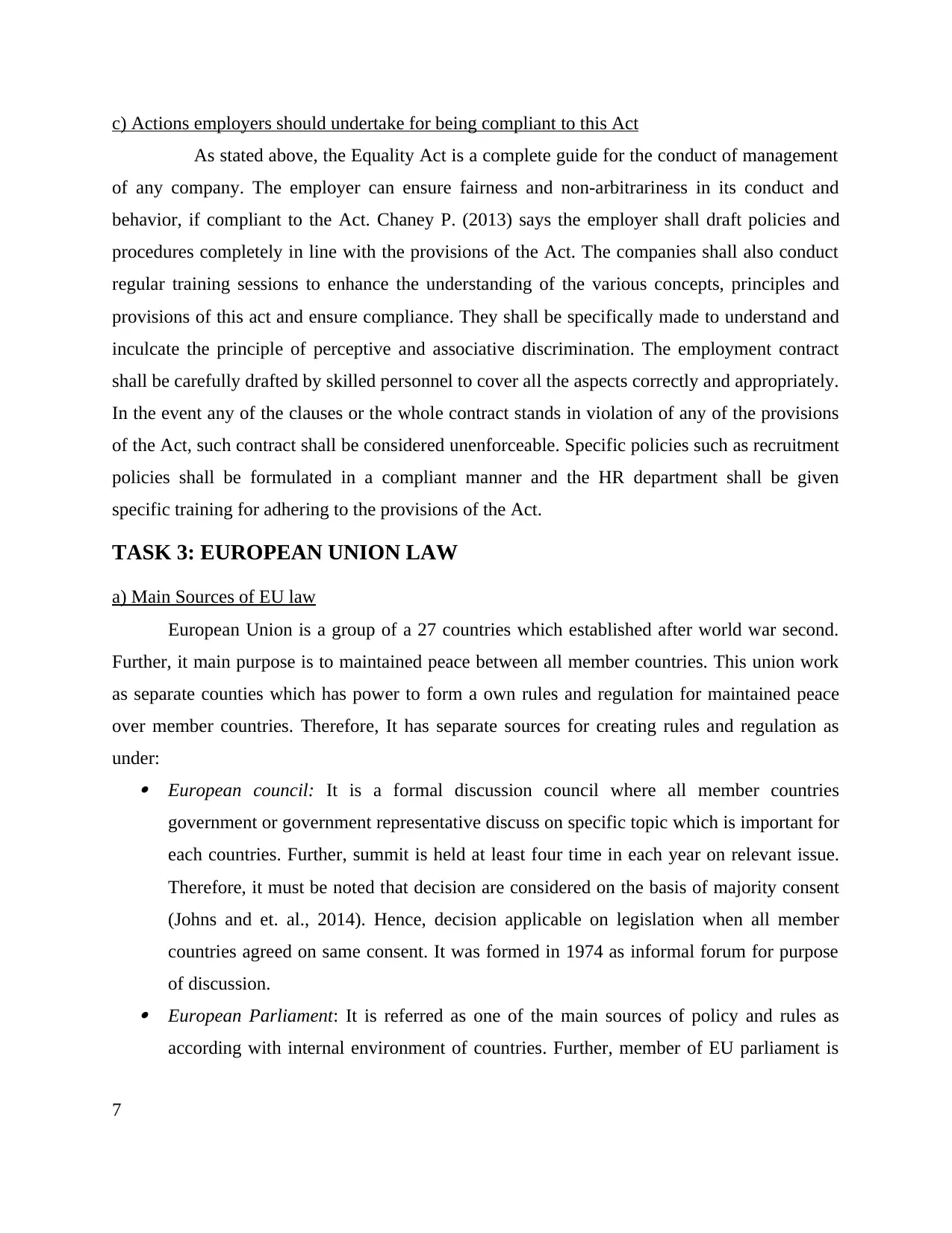
c) Actions employers should undertake for being compliant to this Act
As stated above, the Equality Act is a complete guide for the conduct of management
of any company. The employer can ensure fairness and non-arbitrariness in its conduct and
behavior, if compliant to the Act. Chaney P. (2013) says the employer shall draft policies and
procedures completely in line with the provisions of the Act. The companies shall also conduct
regular training sessions to enhance the understanding of the various concepts, principles and
provisions of this act and ensure compliance. They shall be specifically made to understand and
inculcate the principle of perceptive and associative discrimination. The employment contract
shall be carefully drafted by skilled personnel to cover all the aspects correctly and appropriately.
In the event any of the clauses or the whole contract stands in violation of any of the provisions
of the Act, such contract shall be considered unenforceable. Specific policies such as recruitment
policies shall be formulated in a compliant manner and the HR department shall be given
specific training for adhering to the provisions of the Act.
TASK 3: EUROPEAN UNION LAW
a) Main Sources of EU law
European Union is a group of a 27 countries which established after world war second.
Further, it main purpose is to maintained peace between all member countries. This union work
as separate counties which has power to form a own rules and regulation for maintained peace
over member countries. Therefore, It has separate sources for creating rules and regulation as
under: European council: It is a formal discussion council where all member countries
government or government representative discuss on specific topic which is important for
each countries. Further, summit is held at least four time in each year on relevant issue.
Therefore, it must be noted that decision are considered on the basis of majority consent
(Johns and et. al., 2014). Hence, decision applicable on legislation when all member
countries agreed on same consent. It was formed in 1974 as informal forum for purpose
of discussion. European Parliament: It is referred as one of the main sources of policy and rules as
according with internal environment of countries. Further, member of EU parliament is
7
As stated above, the Equality Act is a complete guide for the conduct of management
of any company. The employer can ensure fairness and non-arbitrariness in its conduct and
behavior, if compliant to the Act. Chaney P. (2013) says the employer shall draft policies and
procedures completely in line with the provisions of the Act. The companies shall also conduct
regular training sessions to enhance the understanding of the various concepts, principles and
provisions of this act and ensure compliance. They shall be specifically made to understand and
inculcate the principle of perceptive and associative discrimination. The employment contract
shall be carefully drafted by skilled personnel to cover all the aspects correctly and appropriately.
In the event any of the clauses or the whole contract stands in violation of any of the provisions
of the Act, such contract shall be considered unenforceable. Specific policies such as recruitment
policies shall be formulated in a compliant manner and the HR department shall be given
specific training for adhering to the provisions of the Act.
TASK 3: EUROPEAN UNION LAW
a) Main Sources of EU law
European Union is a group of a 27 countries which established after world war second.
Further, it main purpose is to maintained peace between all member countries. This union work
as separate counties which has power to form a own rules and regulation for maintained peace
over member countries. Therefore, It has separate sources for creating rules and regulation as
under: European council: It is a formal discussion council where all member countries
government or government representative discuss on specific topic which is important for
each countries. Further, summit is held at least four time in each year on relevant issue.
Therefore, it must be noted that decision are considered on the basis of majority consent
(Johns and et. al., 2014). Hence, decision applicable on legislation when all member
countries agreed on same consent. It was formed in 1974 as informal forum for purpose
of discussion. European Parliament: It is referred as one of the main sources of policy and rules as
according with internal environment of countries. Further, member of EU parliament is
7
Paraphrase This Document
Need a fresh take? Get an instant paraphrase of this document with our AI Paraphraser
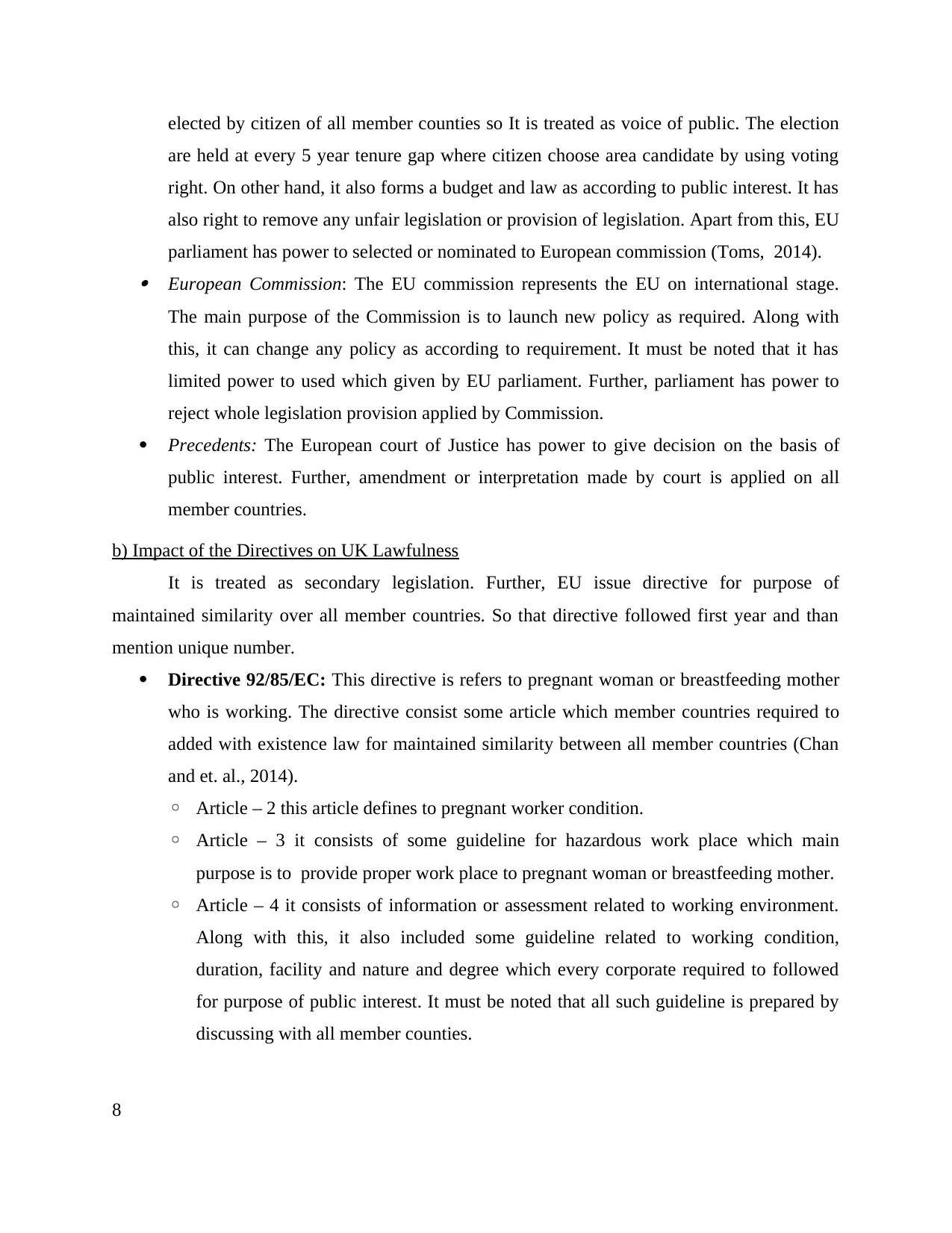
elected by citizen of all member counties so It is treated as voice of public. The election
are held at every 5 year tenure gap where citizen choose area candidate by using voting
right. On other hand, it also forms a budget and law as according to public interest. It has
also right to remove any unfair legislation or provision of legislation. Apart from this, EU
parliament has power to selected or nominated to European commission (Toms, 2014). European Commission: The EU commission represents the EU on international stage.
The main purpose of the Commission is to launch new policy as required. Along with
this, it can change any policy as according to requirement. It must be noted that it has
limited power to used which given by EU parliament. Further, parliament has power to
reject whole legislation provision applied by Commission.
Precedents: The European court of Justice has power to give decision on the basis of
public interest. Further, amendment or interpretation made by court is applied on all
member countries.
b) Impact of the Directives on UK Lawfulness
It is treated as secondary legislation. Further, EU issue directive for purpose of
maintained similarity over all member countries. So that directive followed first year and than
mention unique number.
Directive 92/85/EC: This directive is refers to pregnant woman or breastfeeding mother
who is working. The directive consist some article which member countries required to
added with existence law for maintained similarity between all member countries (Chan
and et. al., 2014).
◦ Article – 2 this article defines to pregnant worker condition.
◦ Article – 3 it consists of some guideline for hazardous work place which main
purpose is to provide proper work place to pregnant woman or breastfeeding mother.
◦ Article – 4 it consists of information or assessment related to working environment.
Along with this, it also included some guideline related to working condition,
duration, facility and nature and degree which every corporate required to followed
for purpose of public interest. It must be noted that all such guideline is prepared by
discussing with all member counties.
8
are held at every 5 year tenure gap where citizen choose area candidate by using voting
right. On other hand, it also forms a budget and law as according to public interest. It has
also right to remove any unfair legislation or provision of legislation. Apart from this, EU
parliament has power to selected or nominated to European commission (Toms, 2014). European Commission: The EU commission represents the EU on international stage.
The main purpose of the Commission is to launch new policy as required. Along with
this, it can change any policy as according to requirement. It must be noted that it has
limited power to used which given by EU parliament. Further, parliament has power to
reject whole legislation provision applied by Commission.
Precedents: The European court of Justice has power to give decision on the basis of
public interest. Further, amendment or interpretation made by court is applied on all
member countries.
b) Impact of the Directives on UK Lawfulness
It is treated as secondary legislation. Further, EU issue directive for purpose of
maintained similarity over all member countries. So that directive followed first year and than
mention unique number.
Directive 92/85/EC: This directive is refers to pregnant woman or breastfeeding mother
who is working. The directive consist some article which member countries required to
added with existence law for maintained similarity between all member countries (Chan
and et. al., 2014).
◦ Article – 2 this article defines to pregnant worker condition.
◦ Article – 3 it consists of some guideline for hazardous work place which main
purpose is to provide proper work place to pregnant woman or breastfeeding mother.
◦ Article – 4 it consists of information or assessment related to working environment.
Along with this, it also included some guideline related to working condition,
duration, facility and nature and degree which every corporate required to followed
for purpose of public interest. It must be noted that all such guideline is prepared by
discussing with all member counties.
8
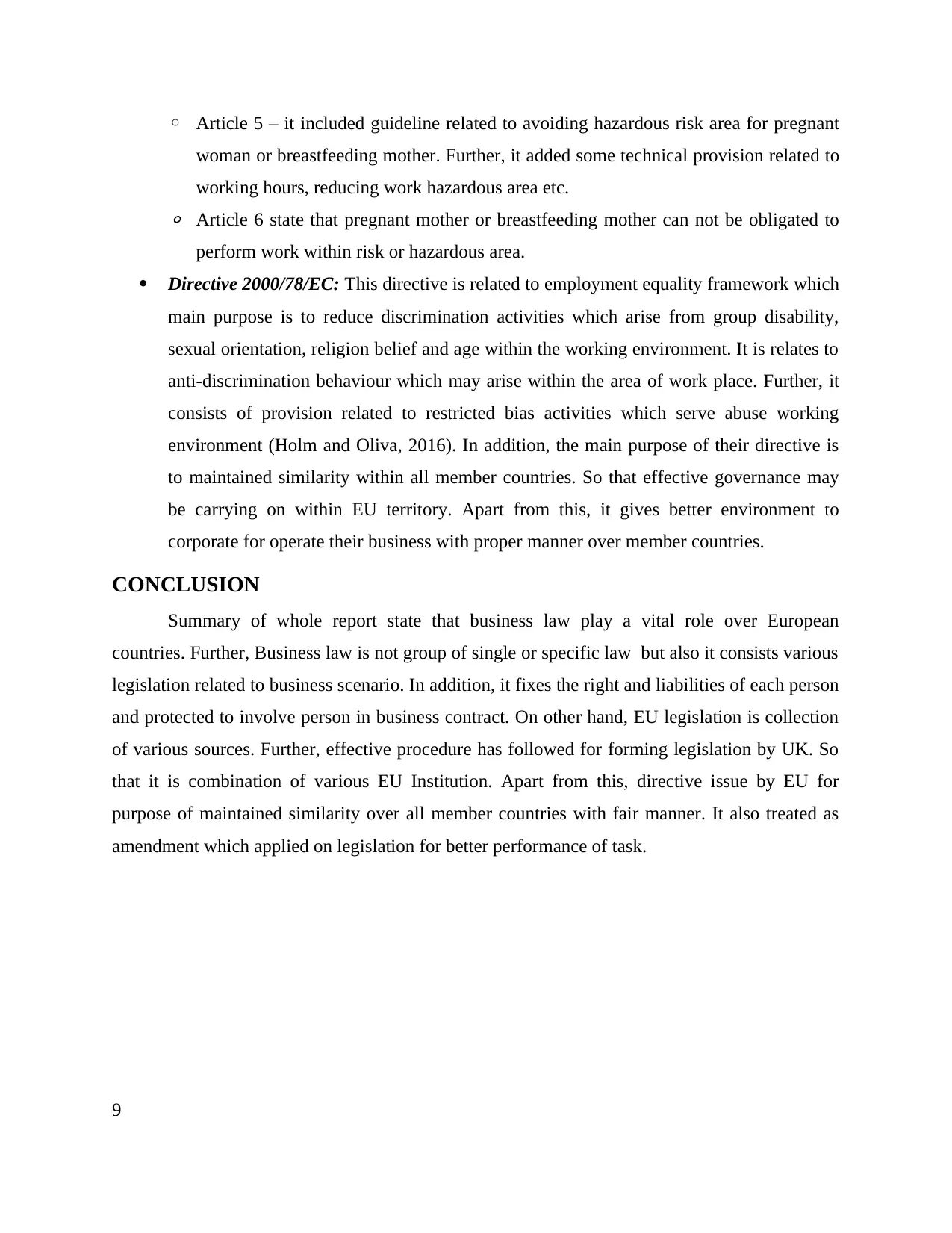
◦ Article 5 – it included guideline related to avoiding hazardous risk area for pregnant
woman or breastfeeding mother. Further, it added some technical provision related to
working hours, reducing work hazardous area etc.
◦ Article 6 state that pregnant mother or breastfeeding mother can not be obligated to
perform work within risk or hazardous area.
Directive 2000/78/EC: This directive is related to employment equality framework which
main purpose is to reduce discrimination activities which arise from group disability,
sexual orientation, religion belief and age within the working environment. It is relates to
anti-discrimination behaviour which may arise within the area of work place. Further, it
consists of provision related to restricted bias activities which serve abuse working
environment (Holm and Oliva, 2016). In addition, the main purpose of their directive is
to maintained similarity within all member countries. So that effective governance may
be carrying on within EU territory. Apart from this, it gives better environment to
corporate for operate their business with proper manner over member countries.
CONCLUSION
Summary of whole report state that business law play a vital role over European
countries. Further, Business law is not group of single or specific law but also it consists various
legislation related to business scenario. In addition, it fixes the right and liabilities of each person
and protected to involve person in business contract. On other hand, EU legislation is collection
of various sources. Further, effective procedure has followed for forming legislation by UK. So
that it is combination of various EU Institution. Apart from this, directive issue by EU for
purpose of maintained similarity over all member countries with fair manner. It also treated as
amendment which applied on legislation for better performance of task.
9
woman or breastfeeding mother. Further, it added some technical provision related to
working hours, reducing work hazardous area etc.
◦ Article 6 state that pregnant mother or breastfeeding mother can not be obligated to
perform work within risk or hazardous area.
Directive 2000/78/EC: This directive is related to employment equality framework which
main purpose is to reduce discrimination activities which arise from group disability,
sexual orientation, religion belief and age within the working environment. It is relates to
anti-discrimination behaviour which may arise within the area of work place. Further, it
consists of provision related to restricted bias activities which serve abuse working
environment (Holm and Oliva, 2016). In addition, the main purpose of their directive is
to maintained similarity within all member countries. So that effective governance may
be carrying on within EU territory. Apart from this, it gives better environment to
corporate for operate their business with proper manner over member countries.
CONCLUSION
Summary of whole report state that business law play a vital role over European
countries. Further, Business law is not group of single or specific law but also it consists various
legislation related to business scenario. In addition, it fixes the right and liabilities of each person
and protected to involve person in business contract. On other hand, EU legislation is collection
of various sources. Further, effective procedure has followed for forming legislation by UK. So
that it is combination of various EU Institution. Apart from this, directive issue by EU for
purpose of maintained similarity over all member countries with fair manner. It also treated as
amendment which applied on legislation for better performance of task.
9
⊘ This is a preview!⊘
Do you want full access?
Subscribe today to unlock all pages.

Trusted by 1+ million students worldwide
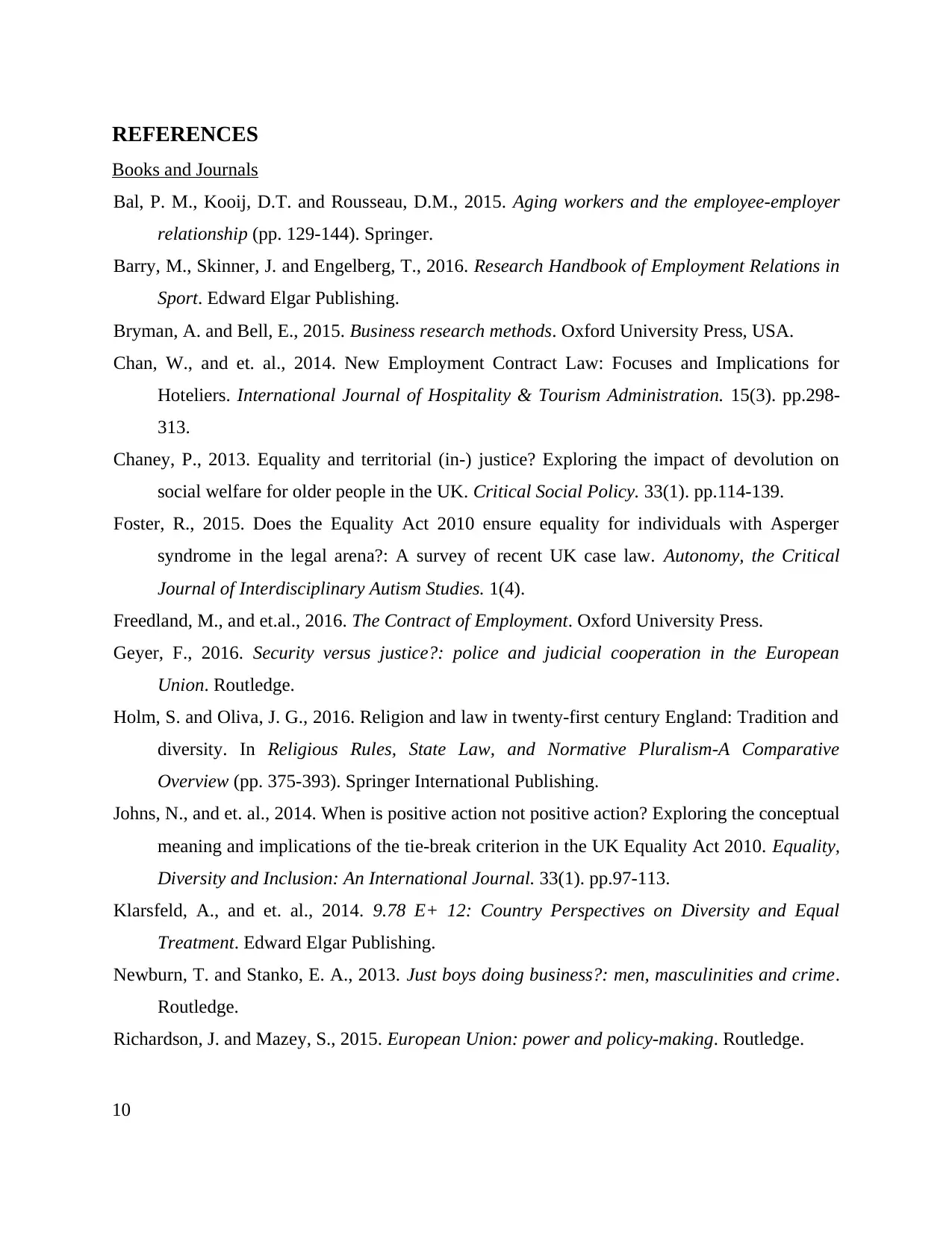
REFERENCES
Books and Journals
Bal, P. M., Kooij, D.T. and Rousseau, D.M., 2015. Aging workers and the employee-employer
relationship (pp. 129-144). Springer.
Barry, M., Skinner, J. and Engelberg, T., 2016. Research Handbook of Employment Relations in
Sport. Edward Elgar Publishing.
Bryman, A. and Bell, E., 2015. Business research methods. Oxford University Press, USA.
Chan, W., and et. al., 2014. New Employment Contract Law: Focuses and Implications for
Hoteliers. International Journal of Hospitality & Tourism Administration. 15(3). pp.298-
313.
Chaney, P., 2013. Equality and territorial (in-) justice? Exploring the impact of devolution on
social welfare for older people in the UK. Critical Social Policy. 33(1). pp.114-139.
Foster, R., 2015. Does the Equality Act 2010 ensure equality for individuals with Asperger
syndrome in the legal arena?: A survey of recent UK case law. Autonomy, the Critical
Journal of Interdisciplinary Autism Studies. 1(4).
Freedland, M., and et.al., 2016. The Contract of Employment. Oxford University Press.
Geyer, F., 2016. Security versus justice?: police and judicial cooperation in the European
Union. Routledge.
Holm, S. and Oliva, J. G., 2016. Religion and law in twenty-first century England: Tradition and
diversity. In Religious Rules, State Law, and Normative Pluralism-A Comparative
Overview (pp. 375-393). Springer International Publishing.
Johns, N., and et. al., 2014. When is positive action not positive action? Exploring the conceptual
meaning and implications of the tie-break criterion in the UK Equality Act 2010. Equality,
Diversity and Inclusion: An International Journal. 33(1). pp.97-113.
Klarsfeld, A., and et. al., 2014. 9.78 E+ 12: Country Perspectives on Diversity and Equal
Treatment. Edward Elgar Publishing.
Newburn, T. and Stanko, E. A., 2013. Just boys doing business?: men, masculinities and crime.
Routledge.
Richardson, J. and Mazey, S., 2015. European Union: power and policy-making. Routledge.
10
Books and Journals
Bal, P. M., Kooij, D.T. and Rousseau, D.M., 2015. Aging workers and the employee-employer
relationship (pp. 129-144). Springer.
Barry, M., Skinner, J. and Engelberg, T., 2016. Research Handbook of Employment Relations in
Sport. Edward Elgar Publishing.
Bryman, A. and Bell, E., 2015. Business research methods. Oxford University Press, USA.
Chan, W., and et. al., 2014. New Employment Contract Law: Focuses and Implications for
Hoteliers. International Journal of Hospitality & Tourism Administration. 15(3). pp.298-
313.
Chaney, P., 2013. Equality and territorial (in-) justice? Exploring the impact of devolution on
social welfare for older people in the UK. Critical Social Policy. 33(1). pp.114-139.
Foster, R., 2015. Does the Equality Act 2010 ensure equality for individuals with Asperger
syndrome in the legal arena?: A survey of recent UK case law. Autonomy, the Critical
Journal of Interdisciplinary Autism Studies. 1(4).
Freedland, M., and et.al., 2016. The Contract of Employment. Oxford University Press.
Geyer, F., 2016. Security versus justice?: police and judicial cooperation in the European
Union. Routledge.
Holm, S. and Oliva, J. G., 2016. Religion and law in twenty-first century England: Tradition and
diversity. In Religious Rules, State Law, and Normative Pluralism-A Comparative
Overview (pp. 375-393). Springer International Publishing.
Johns, N., and et. al., 2014. When is positive action not positive action? Exploring the conceptual
meaning and implications of the tie-break criterion in the UK Equality Act 2010. Equality,
Diversity and Inclusion: An International Journal. 33(1). pp.97-113.
Klarsfeld, A., and et. al., 2014. 9.78 E+ 12: Country Perspectives on Diversity and Equal
Treatment. Edward Elgar Publishing.
Newburn, T. and Stanko, E. A., 2013. Just boys doing business?: men, masculinities and crime.
Routledge.
Richardson, J. and Mazey, S., 2015. European Union: power and policy-making. Routledge.
10
Paraphrase This Document
Need a fresh take? Get an instant paraphrase of this document with our AI Paraphraser

Robson, L., Patel, M. and Nicholson, J., 2016. National Association of Disabled Staff Networks
(NADSN)–“Our Stories: Experiences from our Disabled Staff Networks across the UK”.
The Journal of Inclusive Practice in further and higher education. (7). pp.28-33.
Selwyn, N. M. and Emir, A., 2014. Selwyn's law of employment. Oxford University Press, USA.
Toms, S., 2014. The Flexibility, Isolation, and Vulnerability of Agency Working A Qualitative
Psychological Study. GSTF Business Review (GBR). 3(4). p.34.
Whish, R. and Bailey, D., 2015. Competition law. Oxford University Press, USA.
Online
Briefing Paper - The Equality Act 2010:Caste discrimination, 2015. [PDF]. Accessed through
<researchbriefings.files.parliament.uk/documents/SN06862/SN06862.pdf> [Accessed on
10th August, 2016]
11
(NADSN)–“Our Stories: Experiences from our Disabled Staff Networks across the UK”.
The Journal of Inclusive Practice in further and higher education. (7). pp.28-33.
Selwyn, N. M. and Emir, A., 2014. Selwyn's law of employment. Oxford University Press, USA.
Toms, S., 2014. The Flexibility, Isolation, and Vulnerability of Agency Working A Qualitative
Psychological Study. GSTF Business Review (GBR). 3(4). p.34.
Whish, R. and Bailey, D., 2015. Competition law. Oxford University Press, USA.
Online
Briefing Paper - The Equality Act 2010:Caste discrimination, 2015. [PDF]. Accessed through
<researchbriefings.files.parliament.uk/documents/SN06862/SN06862.pdf> [Accessed on
10th August, 2016]
11
1 out of 11
Related Documents
Your All-in-One AI-Powered Toolkit for Academic Success.
+13062052269
info@desklib.com
Available 24*7 on WhatsApp / Email
![[object Object]](/_next/static/media/star-bottom.7253800d.svg)
Unlock your academic potential
Copyright © 2020–2025 A2Z Services. All Rights Reserved. Developed and managed by ZUCOL.





